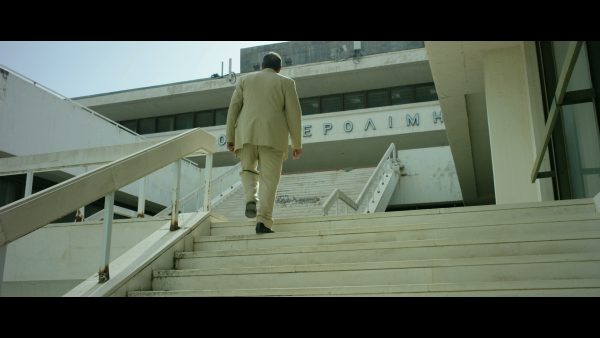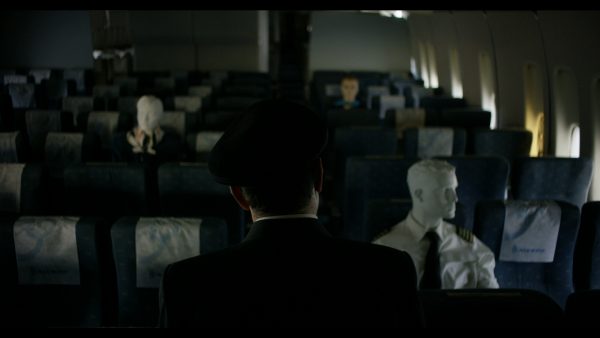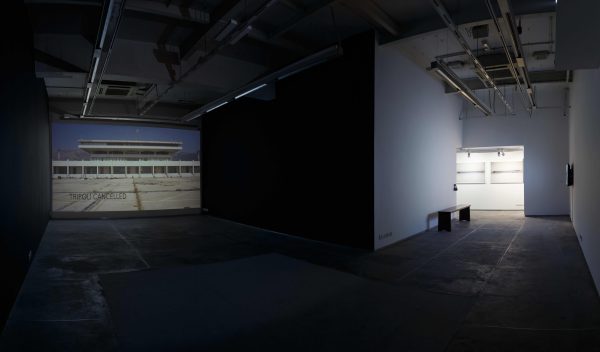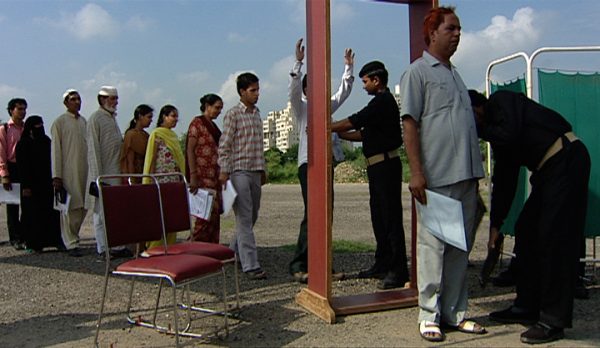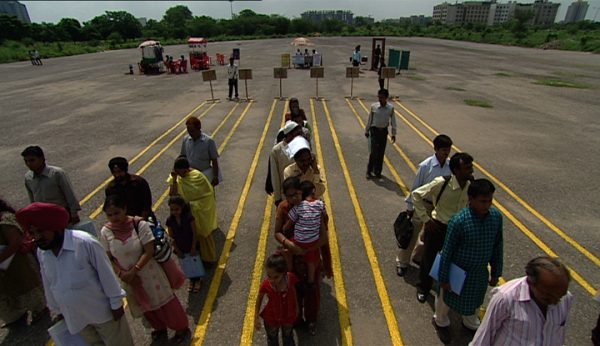Loneliness is mostly narrative. It also has an aesthetic: an empty tableau in which the lonely act is performed. In Naeem Mohaiemen’s Tripoli Cancelled (2017), a man roams the large expanse of a disused airport – Athens’s Ellinikon, designed by Eero Saarinen in the 1960s. It is unclear whether he is trapped there by circumstance, or of his own volition; we never once see him trying to leave. This narrative of loneliness is played out with great precision. The protagonist lifts bags off an abandoned luggage belt and places them in a careful pile on the floor before folding himself into a foetal position on the conveyor. Later, he carefully hangs his blazer onto the jagged frame of an idle helicopter, before stepping into the pilot’s seat. In one of the last scenes in the film, he gently dislodges the top halves of flight crew mannequins before carrying them onto an empty plane, placing them into seats. Very carefully, he pulls apart the buttons of an air stewardess’s blouse, before cupping a single, plastic breast.
The last aircraft to take off from Ellinikon was an Olympic Airways flight to Thessaloníki in 2001. Our protagonist stares up at the announcement of this flight’s departure, and as the camera reels upward – there are only ruined cables, and metal debris. In Humiliation, Wayne Koestenbaum writes, ‘To study a subject is to humiliate the subject, and to humiliate oneself by the process of studying it.’ The humiliations in Tripoli Cancelled exist in entangled layers. In the slow unravelling of the protagonist’s masculinity, and in the humiliation of the airport itself, and what it represents: a grandstanding modernism, and a paean to globalisation.
Bani Abidi’s film The Distance From Here (2010) opens with a close-up of an arrangement of objects upon tarmac – a clunky typewriter, a pair of orange and white umbrellas, two irregular tables propped against each other, an empty chair. As the camera widens, we see a large, empty maidan, with a narrow wooden doorway acting as the point of entry. Abidi seems to reference similar grounds in South Asia, where crowds gather to board shuttles to embassies for their visa appointments. And, as with any intermediary space in the subcontinent, these sites become ripe for informal economies to take over. Signs read: ‘Legal Documentation Centre (Regd.)’ and ‘NOTARY PUBLIC’. People quietly assemble and file into lines marked by yellow tape. They straighten their jackets and fix their hair, slide on elastic ties. They click open and shut the plastic buttons on their clear plastic folders in which they keep their documents. The scene, and the objects it assembles, is entirely familiar to those that that are accustomed to the visa application process: the ties a necessary uniform; the Notary at hand to witness and confirm documents at the very last minute; and the typewriter to neatly fill in still unfinished forms. Every movement is banal and perfunctory, yet instilled with a deep anxiety and restlessness, not unlike the application process itself.
Both films have been brought together, along with a series of photographs by Abidi, as part of Kolkata-based Gallery Experimenter’s ‘I wish to let you fall out of my hands’ Chapter I (Chapter II will mark the opening of the gallery’s new space at the end of the month). In the essay The Sight of Death, TJ Clark stays with an analysis of just two paintings by Nicolas Poussin for over 200 pages. For Clark it’s all about a slow focus, ‘this staying still, this allowing oneself to respond to the picture’s stillness.’ Both The Distance From Here and Tripoli Cancelled are unhurried meditations, with special attention to form. In a political moment at which South Asians carry the immense burden of representation, there is something refreshing about an approach that does not indulge in hyperbole. And, perhaps, where one film finishes, the other begins. If Tripoli Cancelled may be read as a critique, and a move towards the undoing of modernism and globalisation, The Distance From Here gives us what happens after the global failure of leftist internationalism. Here is where we are now: nation states defined by their borders, and the desperation of many for nation states outside of their own.
In 1965, Susan’s Sontag declared that we have arrived at an ‘age of extremity,’ one that is defined by, ‘the continual threat of two equally fearful, but seemingly opposed destinies: unremitting banality and inconceivable terror.’ These films are cognisant of both ends of the spectrum, and their narratives are a fast vibration between the two. Every moment is an opportunity for the protagonists, and us as viewers, to succumb to either one.
